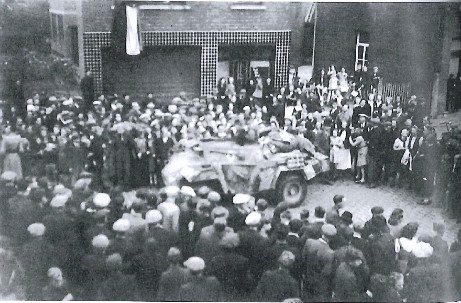The end of the war was already in sight in Heist-op-den-Berg in August 1944. On 29 August, the women and children of the German occupiers in Heist took the train towards Germany. Over the following days, defeated, tired Germans passed by. It was a chaotic and sometimes violent retreat. On 3 September, Heistians saw British planes flying overhead; explosions could be heard in the distance at night.
The next day, the first Belgian flag appeared. A brave resident of Heist-Goor hung it out, others followed. People were ready with flower wreaths and tricoloured bows. But no liberator was yet to be seen. On 5 September, the British finally appeared with their tanks. The population reacted exuberantly, women fell around the soldiers' necks, more flags appeared and the brass band made themselves heard.
The British stayed until January 1945. They were stationed at Mechelbaan and Hof ter Laken, among other places. Especially for them, curate Druyts preached in English in St Lambert's church at Christmas.
From November 1944, the Germans strafed the port of Antwerp with 'flying bombs'. The Allies placed anti-aircraft guns and tried to detonate the bombs in the air, or deflect them to less populated areas. In Heist-op-den-Berg, Booischot, Hallaar, Itegem, Schriek and Wiekevorst together, 31 V1 and 7 V2 bombs fell. 60 people were injured and 12 killed. Over 500 houses were slightly or heavily damaged, 27 were completely destroyed.
Tourist information
Cycling routes
Tourism Province of Antwerp has created liberation routes along the cycle junction network. Cycle and walk past the places where it all happened, such as monuments, military cemeteries and crash sites. For the liberation routes, go to fietsroutes.provincieantwerpen.be
